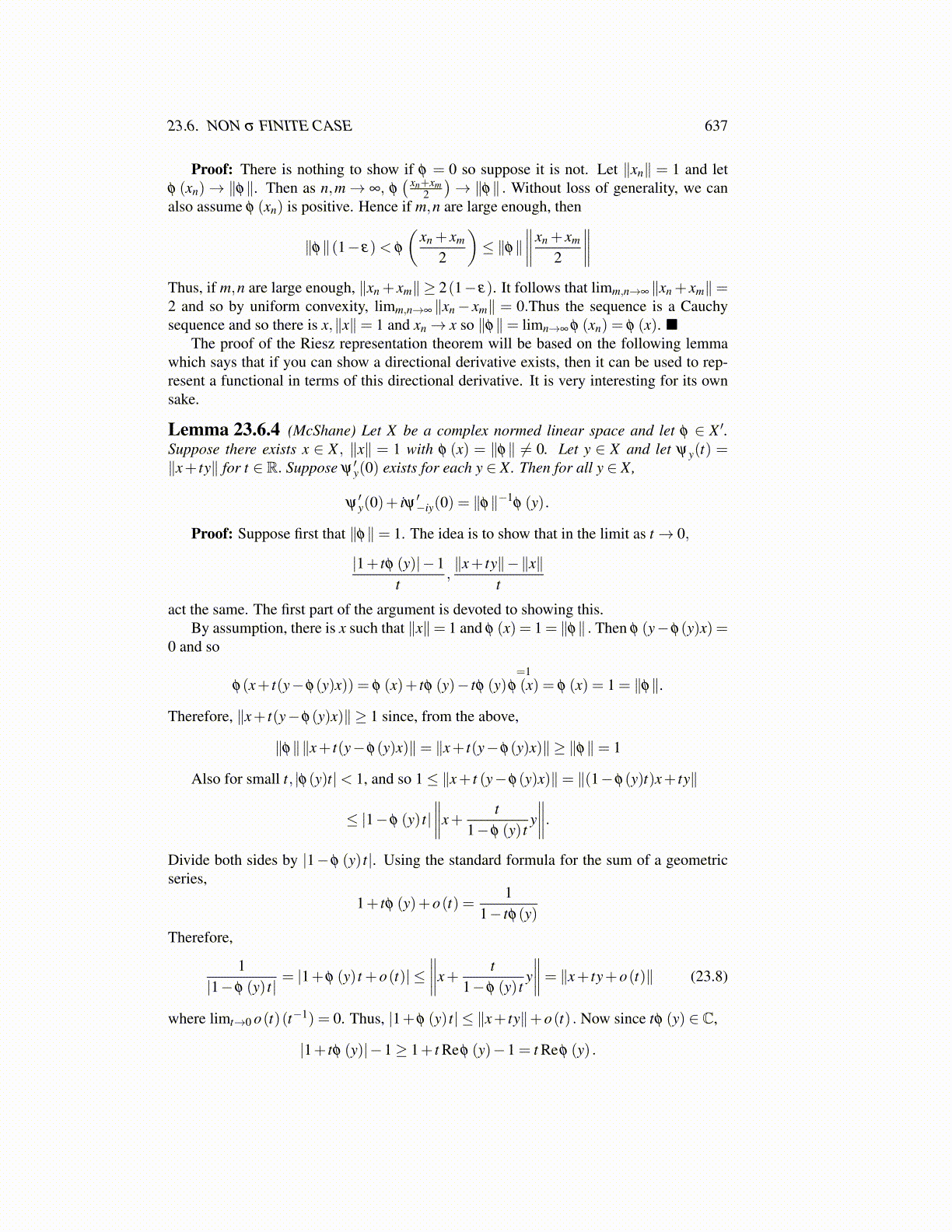
23.6. NON σ FINITE CASE 637
Proof: There is nothing to show if φ = 0 so suppose it is not. Let ∥xn∥ = 1 and letφ (xn)→ ∥φ∥. Then as n,m→ ∞, φ
( xn+xm2
)→ ∥φ∥ . Without loss of generality, we can
also assume φ (xn) is positive. Hence if m,n are large enough, then
∥φ∥(1− ε)< φ
(xn + xm
2
)≤ ∥φ∥
∥∥∥∥xn + xm
2
∥∥∥∥Thus, if m,n are large enough, ∥xn + xm∥ ≥ 2(1− ε). It follows that limm,n→∞ ∥xn + xm∥=2 and so by uniform convexity, limm,n→∞ ∥xn− xm∥ = 0.Thus the sequence is a Cauchysequence and so there is x,∥x∥= 1 and xn→ x so ∥φ∥= limn→∞ φ (xn) = φ (x). ■
The proof of the Riesz representation theorem will be based on the following lemmawhich says that if you can show a directional derivative exists, then it can be used to rep-resent a functional in terms of this directional derivative. It is very interesting for its ownsake.
Lemma 23.6.4 (McShane) Let X be a complex normed linear space and let φ ∈ X ′.Suppose there exists x ∈ X , ∥x∥ = 1 with φ (x) = ∥φ∥ ̸= 0. Let y ∈ X and let ψy(t) =∥x+ ty∥ for t ∈ R. Suppose ψ ′y(0) exists for each y ∈ X. Then for all y ∈ X,
ψ′y(0)+ iψ ′−iy(0) = ∥φ∥−1
φ (y) .
Proof: Suppose first that ∥φ∥= 1. The idea is to show that in the limit as t→ 0,
|1+ tφ (y)|−1t
,∥x+ ty∥−∥x∥
t
act the same. The first part of the argument is devoted to showing this.By assumption, there is x such that ∥x∥= 1 and φ (x) = 1 = ∥φ∥ . Then φ (y−φ(y)x) =
0 and so
φ(x+ t(y−φ(y)x)) = φ (x)+ tφ (y)− tφ (y)=1
φ (x) = φ (x) = 1 = ∥φ∥.
Therefore, ∥x+ t(y−φ(y)x)∥ ≥ 1 since, from the above,
∥φ∥∥x+ t(y−φ(y)x)∥= ∥x+ t(y−φ(y)x)∥ ≥ ∥φ∥= 1
Also for small t, |φ(y)t|< 1, and so 1≤ ∥x+ t (y−φ(y)x)∥= ∥(1−φ(y)t)x+ ty∥
≤ |1−φ (y) t|∥∥∥∥x+
t1−φ (y) t
y∥∥∥∥.
Divide both sides by |1−φ (y) t|. Using the standard formula for the sum of a geometricseries,
1+ tφ (y)+o(t) =1
1− tφ(y)
Therefore,
1|1−φ (y) t|
= |1+φ (y) t +o(t)| ≤∥∥∥∥x+
t1−φ (y) t
y∥∥∥∥= ∥x+ ty+o(t)∥ (23.8)
where limt→0 o(t)(t−1) = 0. Thus, |1+φ (y) t| ≤ ∥x+ ty∥+o(t) . Now since tφ (y) ∈ C,
|1+ tφ (y)|−1≥ 1+ t Reφ (y)−1 = t Reφ (y) .